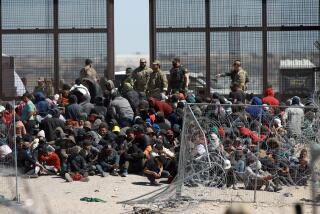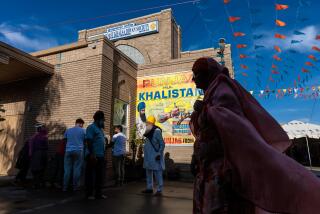This border barrier got built — and it’s upended lives in Pakistan and Afghanistan
For generations, families on both sides of the Pakistan-Afghanistan border worked together to till the fields of wheat, corn and rice that spread across the rugged plains.
With no physical boundary between the countries, the families joined forces every year to desilt the canal that irrigated the lands. They shared not only ethnic and blood bonds, but also the harvests from the fertile soil.
But a year and a half ago, the cross-border farming came to a stop. The Pakistani army began erecting a chain-link fence topped with coils of razor wire.
Syed Gul, a Pakistani farmer who owns 20 acres that straddle both sides near the Pakistani town of Kharlachi, cannot access the Afghan side, and Pakistani soldiers have told him not even to approach the land that lies inside Pakistan because getting too close to the fence would constitute a security breach.
“The land has been made barren since the government fenced the border,” said Gul, 55.
The barrier is part of the Pakistani government’s response to long-standing criticisms that it has failed to control the movement of militants across the porous border.
Its border management plan, launched in 2017, calls for a divider along all 1,600 miles of the frontier, with backing by closed-circuit television cameras and drone footage, along with hundreds of checkpoints. The army said in January that about 560 miles of fence had been completed at a cost of about $460 million.
The region, which consists of 10,400 square miles of tribal land, was once considered a haven for Al Qaeda, the Taliban and other militant outfits. Some 3 million civilians have been displaced there over the past decade.
The area has been relatively calm since the army launched an offensive beginning in 2014 that it said cleared out the insurgents.
Islamabad says the fencing will disrupt militants plotting terrorist attacks in Afghanistan and Pakistan. But in an impoverished and undeveloped region, where farming and illicit cross-border trade were among the only sources of income, the fence has upended lives.
Gul’s Pashtun ethnic group has seen both sides of the border as its homeland for centuries. Pashtuns moved freely across it during the British colonial era, even after the 1893 Durand Line agreement formally demarcated the boundary.
“We never considered it a border between two countries,” Gul said. “People did not seek verbal permission from the officials patrolling the border when they needed to work in their fields on the Afghanistan side.”
Pakistanis from certain tribes living along the border once needed only a “red pass” issued by the Pakistani tribal affairs department in the city of Peshawar that allowed unlimited movement back and forth across the border. The pass was gradually withdrawn in the 1970s and 1980s, but since then most Pakistanis crossed into Afghanistan without visas.
“I got on the bus with my friends in Peshawar and went to Kabul by bus to watch Indian movies in the cinema,” recalled Ziaul Haq Sarhadi, a 65-year-old trader in Peshawar.
The fence has cut off thousands of families who share the same culture, traditions, language, religion and land. Many people in Pakistan’s tribal region sold their lands inside Afghanistan when the border management plan was introduced.
“We sold 100 acres of land in Paktika” — a border province in eastern Afghanistan — “at a throwaway price,” said Dilawar Wazir, a resident of Pakistan’s South Waziristan tribal district.
Official trade between the two countries has also fallen, harming Afghanistan’s landlocked and war-battered economy. Pakistani exports to Afghanistan, which amounted to $2.6 billion in 2010-11, fell to $1.4 billion last year, according to government statistics.
Ibrahim Shinwari, a small businessman living in the Khyber tribal district, said Pakistan’s border plan has left 2,500 people jobless in the border town of Torkham, formerly a major transit terminal for goods between the two countries that was also used by U.S.-led international forces to bring supplies into Afghanistan.
Six out of nine restaurants in Torkham have closed, he said, and the daily flow of vehicles crossing in and out of Afghanistan has slowed from the thousands to the hundreds.
“No more is the place buzzing with economic activity as it once did,” Shinwari said. “All that hustle and bustle has died down into economic depression.”
Azmat Hayat, former director of the Area Study Center at the University of Peshawar, said that before the U.S. invaded Afghanistan in 2001, the border was ignored.
“The Durand Line is a reality because of the changing geostrategic situation in the region,” Hayat said.
Traditions are also dying, with families on either side of the border unable to celebrate festivals together or visit the houses of sick or deceased relatives on the other side to offer condolences.
“It has brought an end to family relations,” said Nadir Manan, a Pakistani who said he couldn’t attend the recent wedding of his niece in Afghanistan.
Pakistan’s former ambassador to Afghanistan, Rustam Shah Mohmand, called the fencing “disastrous” and said it violated more than a century’s worth of agreements between the countries to allow free movement, particularly of families with historical ties to the land.
“The government cannot stop cross-border movement of terrorists by erecting the fence,” Mohmand said. “It just cuts off families and will cause acrimony between the two countries.”
Ali is a special correspondent.
More to Read
Start your day right
Sign up for Essential California for news, features and recommendations from the L.A. Times and beyond in your inbox six days a week.
You may occasionally receive promotional content from the Los Angeles Times.






